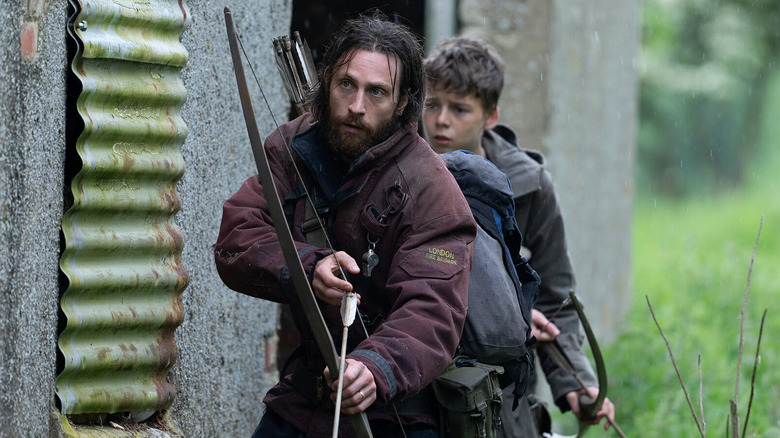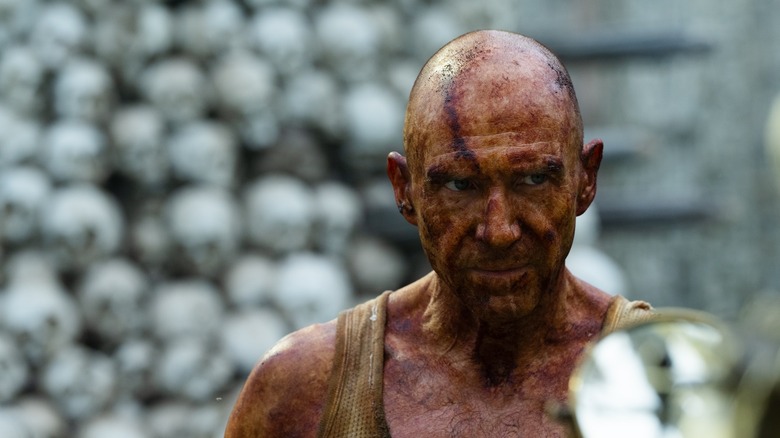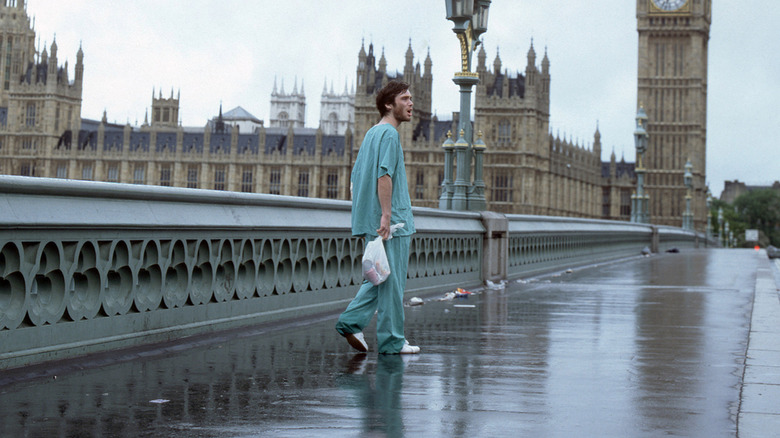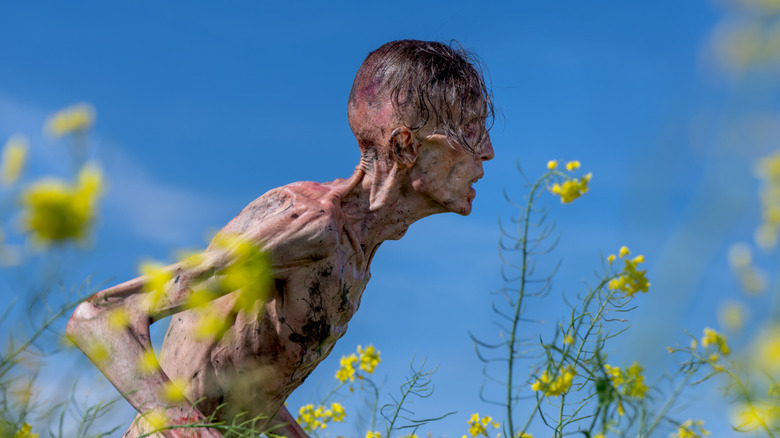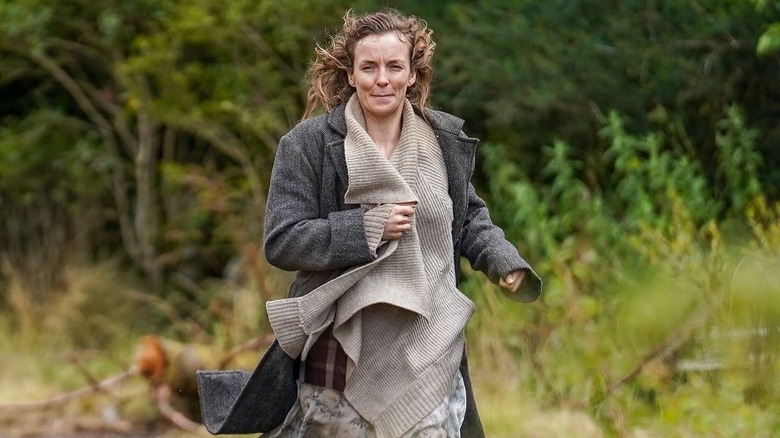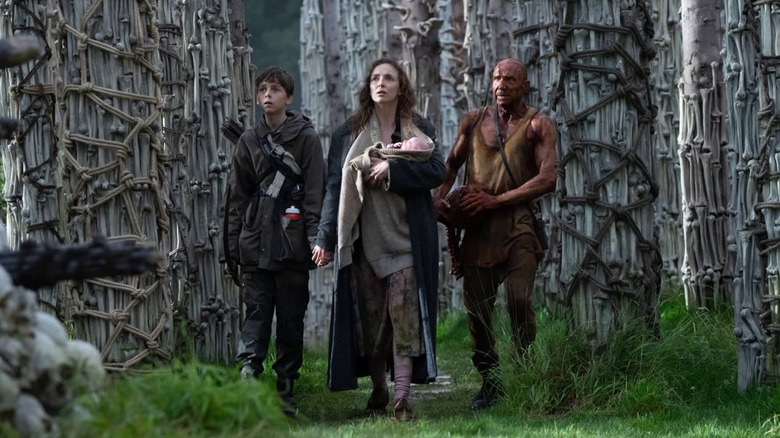5 Reasons Why 28 Years Later Killed It At The Box Office
While it took a lot longer than many filmgoers would have liked, director Danny Boyle and writer Alex Garland finally reunited for "28 Years Later," which hit theaters over the weekend. Serving as a sequel to their horror classic "28 Days Later" (and its follow-up "28 Weeks Later"), the movie picks up with a group of survivors nearly three decades into a zombie apocalypse. It's an intriguing concept that managed to bring out moviegoers en masse, leading to one heck of an opening weekend.
Sony's "28 Years Later" opened to an estimated $30 million at the domestic box office while bringing in an additional $30 million overseas. That wasn't enough to take the crown away from the live-action "How to Train Your Dragon" remake ($37 million), but it's worth noting the latter is a PG-rated family movie that's playing on nearly 4,400 screens in North America. By contrast, "28 Years Later" is an R-rated horror flick playing on 3,444 screens. All things considered, then, this is a very good result, even when taking the film's reported $60 million budget into account.
Big-budget horror is always risky, with the likes of "World War Z" being the exception rather than the rule in that department (at least so far as their box office success is concerned). In any event, "28 Years Later" managed to snag the biggest opening weekend for a live-action zombie movie in years, at least dating back to 2019's "Zombieland: Double Tap" ($26.8 million opening/$122.8 million worldwide). Zombie films have historically been lower budget affairs, but Boyle, Garland, and Sony had bigger ambitions with this undertaking.
So, what went right here? How did Boyle and Garland manage to successfully craft the rare big-budget horror hit? We're going to take a closer look at the main reasons why "28 Years Later" became a big box office success during its opening weekend. Let's dig in.
28 Years Later arrived with very positive reviews
Particularly in the realm of horror, it helps when a given movie can get critics on its side. Horror can be one of the more critic-proof genres out there, but when a genre flick also manages to earn critical acclaim, its box office prospects absolutely go up. In the case of "28 Years Later," critics were very kind to what Boyle and Garland cooked up. It currently boasts an 89% critical approval rating on Rotten Tomatoes, which is damn good for a zombie movie.
Audiences were, admittedly, a bit more mixed. The RT audience rating sits at 65%, and the film earned a B CinemaScore. That, coupled with stiff competition from the likes of "M3GAN 2.0" and "F1" coming down the pipeline, might make a strong second weekend hold more challenging. Still, so long as the movie doesn't completely collapse, Sony should be able to parlay the critical buzz from its opening frame for at least a few more weeks.
In his own review for /Film, Chris Evangelista wrote that "28 Years Later" comes "close to being one of the best zombie movies ever made." It also boasts a solid cast led by Jodie Comer ("Free Guy"), Aaron Taylor-Johnson ("Kraven the Hunter"), and Ralph Fiennes ("The Menu"), alongside newcomer Alfie Williams.
28 Days Later has become a stone cold genre classic
What's particularly interesting about "28 Years Later" is that the very long wait between sequels may well have helped turn this movie into a bigger event. Mind you, for a while there it looked like this movie would be taking on the form of "28 Months Later." Needless to say, it took Boyle and Garland a while to actually get it made. But in the time since "28 Weeks Later" arrived 18 years ago, "28 Days Later" has become a stone-cold horror classic without the need for a caveat. It's now 23 years old and its place as an all-time horror favorite is set in stone.
That movie's status in the horror canon has allowed it to become a favorite for multiple generations of fans. Though "28 Days Later" was inexplicably difficult to watch for a while, there's no denying its legacy. That being the case, there was some automatic hype built in for "28 Years." One can run the risk of disappointing eager audiences when that much anticipation is built up. Fortunately, based on the critical response and the early turnout, it would be very difficult to label this in any way as a disappointment. Boyle delivered against the weight of those expectations.
The long wait for 28 Years Later paid off
In the old days of Hollywood, sequels could be pumped out in a year, maybe two. Indeed, it's easy to forget there was a new "Friday the 13th" movie coming out annually like clockwork for nearly a decade in the 1980s. Those days are long gone, though, and the wait for sequels can sometimes be very long now. In certain cases, that can hurt a movie's prospects as audiences may simply move on. However, on a long enough timeline, hype can circle back around and, in some cases, swell even larger as a result of the long wait.
It's true: At a certain point, a longer wait can build even more hype in an organic way. That seems to be what happened with "28 Years Later." The notion of a third entry in this property became almost a mythic talking point amongst horror fans. "Will it ever happen?" It's not altogether unlike how James Cameron's "Avatar: The Way of Water" became a monster hit simply because it took Cameron 13 years to finish the damn thing. Granted, Boyle's movie isn't going to make $2 billion at the box office, but a similar rule applies. Absence made the heart grow fonder, as it were.
Sony marketed the hell out of 28 Years Later
When Sony made a deal for "28 Years Later" (one that includes a possible, full-on new trilogy), it committed a lot of money and resources to a franchise that had, all due respect, two modest box office hits that came from low-budget movies to its name. Giving Boyle a $60 million budget was a calculated risk. But Sony's marketing department took on the challenge of making that risk pay off by selling this movie to the masses in a very effective manner. It didn't lean on the notion that this is the first entry in a trilogy or a "part one," which was wise. But it is worth pointing out that "28 Years Later: The Bone Temple" has already been filmed and is set to reach theaters in January 2026.
From that creepy Rudyard Kipling poem in the first "28 Years Later" trailer to highlighting haunting images of evolved zombies of all sorts, the studio somehow managed to effectively market the sequel without giving much of anything away. NEON was able to do something similar with last year's "Longlegs," which became a massive hit built on a stellar marketing campaign. Good marketing does not come easy, and many studios have spent massive fortunes on campaigns for movies that fail to deliver. Sony got it right with this one.
Horror has been delivering the goods lately
There is something to be said about momentum when it comes to success at the box office. It's why so many superhero movies, almost seemingly regardless of perceived quality, were able to limp to sky-high global totals before the pandemic for well over a decade. Horror has a loyal audience, but to make a bigger budget horror offering a hit, more casual moviegoers need to turn up. Fortunately, this year has delivered several high-profile horror films that have helped give the genre some momentum, perhaps encouraging more folks to get off the couch and check out something like "28 Years Later" in a theater (rather than waiting to stream it).
For starters, Ryan Coogler's "Sinners" is one of the biggest success stories of the year and will wrap up its run as one of the most lucrative vampire movies ever. On top of that, Warner Bros. enjoyed its own huge horror franchise revival with "Final Destination Bloodlines," which had a far bigger box office debut than expected. It's now the highest-grossing "Final Destination" movie ever and similarly benefitted from the long wait between installments. The fact that both films were big hits that played well with audiences and critics alike has given mainstream horror very positive momentum as the summer rolls on. That shouldn't be discounted when it comes to the success of "28 Years Later" (or any other horror success stories that emerge in the coming months).
"28 Years Later" is in theaters now.
